Facing the Looming Shadow
by Pringle Franklin
Third in a Series about the Holy Land
JERUSALEM—-The joy and wonder of Bethlehem could not last; I knew this dreaded time would come, yet I had been resisting the plunge into darkness. No pilgrimage to the Holy Land would be complete without walking through the Valley of the Shadow of Death tread by the holy feet of Jesus; rather than remaining skittish, I willed myself to absorb the passion of Christ with deeper comprehension.
I was here to identify with Jesus, yet I did not wish to experience his pain. Alas, to be an authentic pilgrim, one must taste the agony of Christ as well as savor his miracles and victories. The halcyon days back in Galilee, of multiplying the loaves and fishes or turning water into wine, of healing the lame and giving sight to the blind, were behind us; the grim olive press of the Garden of Gethsemane lay around the next bend, casting its long, dark shadow.
****
At first glance, Gethsemane appeared harmless, a small but lovely garden, home to tall wildflowers, aromatic rosemary bushes, and twisted, gnarled olive trees whose buried roots date back to Biblical days. Off to one side sits the Church of All Nations; the centerpiece of this reverent place is the Rock of Agony. The large rock marks the spot where Jesus draped himself for support as he poured out his fervent prayers to God, asking whether the cup of suffering could be removed from his lips.
While Jesus struggled to accept his mission, frightened to the point of sweating blood, his three best friends let him down. Instead of praying that they “not fall into temptation,” as Jesus had asked, Peter, James, and John fell asleep, too weak to help their Master in his greatest hour of need. According to Luke 22:45, the disciples were exhausted from sorrow, as Jesus had forewarned them about his approaching death.
Perhaps their utter helplessness gave Jesus the final proof that the human race would not survive without his self sacrifice. These three favored disciples loved Jesus deeply and yet, left to their own resources and inclinations, even they would fail. Like a row of falling dominoes, the entire Adam project would tumble down, one soul after another.
Was this the Rock of Ages, the place where Christ manifested himself as the willing Savior?
The atmosphere around me felt charged with solemnity. I felt as if I had actually stumbled into the sacred heart of Christ, and that I had become witness to its living, beating presence. The stained-glass windows, featuring white crosses, were radiant with a background palate of purple, the royal color. As bright sunlight passed through the windows, the interior of the sanctuary took on a soft lavender hue; from somewhere, a whirring, repetitive tone filled the air, sounding like a heartbeat.
At home in the morning when I sit in quiet to contemplate and pray, often I play a soothing CD entitled The Frequency of Love that serves as beautiful white noise, to help safeguard me from distraction. The frequency of the repetitive whirring noise in the small church reminded me of this music, and I felt myself relax into its arms. It is a sound that I associate with coming into the presence of the divine within me.
As I sat on a side pew and prayed, surrounded by this acoustic comfort, silently I thanked Jesus for his willingness to take on the burdens of the world. One could sense the agony of his terrible choice within this still and meditative place. And the number one truth that came back to me from the depths of this “sacred heart” was this: the victory had been won by the complete unselfishness of our Lord.
In John 17:19, Jesus says, “Greater love hath no man than this, that a man lay down his life for his friends.”
Jesus took his own teaching to the highest level. In considering this, I pondered: how could I offer more of myself in return?
My mind felt extremely alert, and I felt as if every cell in my body was awakened by the Holy Presence. Of all the places that I visited in the Holy Land, this was the spot where I sensed the deepest connection to the Risen Christ. As I stayed there contemplating, longing to linger, an attendant in the church stepped toward my bench and flipped a switch. The gentle whirring sound slowed and ended; looking up, I saw that it had been coming from a heavy-duty fan mounted on the wall. I felt it was no coincidence that the fan should have been humming like a heartbeat during my short visit.
Somehow my mind memorized the look, sound, and feel of being inside this sacred space. I realized I could return to it at any time in my memory whenever I needed to gain hope and strength from the presence of the Lord.
****
After leaving the Church of All Nations, we lingered in the adjoining garden where Jesus had awaited his accusers: Jewish chief priests and elders, as well as Roman officers of the Temple guard. The garden is surrounded by a steep hillside leading down from higher parts of the city; Jesus would have seen the torches of his enemies as they snaked their way down the footpath to reach him that night.
From then on, everything would change rapidly. Peter, who had sworn in a moment of false bravado never to abandon Jesus, would soon deny even knowing the Nazarene. This scene is commemorated at the Church of St. Peter on Mt. Zion. The church was built over the ruins of the home of the high priest Caiaphas, and it was here in the courtyard by a fire that Peter denied his Lord, three times before the cock crowed. Jesus turned and looked Peter squarely in the eye at that precise moment, just as the guards were leading him away to a prison.
Until now, I had always pictured our Lord confined in a primitive cell.
However, we went into the church and discovered that Jesus had actually been lowered into a pit. As we stood above and peered down, it was like gazing into a dry, deep well. My shoulders hunched and my bones felt momentarily weak as I imagined the bloodied, bruised Jesus lying in a heap at the bottom. Alone, reeling with the pain, frightened.
Next we were allowed to take a stone staircase several flights down to reach dungeon level. Openings had been carved in the rock wall, allowing us to peer inside. Nails and straps attached to the limestone walls attested to the torment that captives such as Jesus had endured here. Inside this underground prison, it felt as if the sun had disappeared from the sky.
I felt repulsed by this place, wanting to see it, yet wanting to flee. If I could barely stay near the malicious pit for 15 minutes, how did Jesus find the fortitude to remain here under the control of evil men? Before his arrest, at the Rock of Agony, Jesus had received comfort from an angel, to strengthen him for this battle. His mind must have returned to the angel’s encouraging words now that he was walking the loneliest road in the world. If only someone who loved Jesus had been there to comfort him…..
In my imagination, I inserted myself into the dungeon, kneeling beside my Lord, touching his back, stroking his hair, offering whatever small help one could manage. If only….my mind hopscotched through various possibilities of my romanticized heroism. Then a very real idea struck me, quite forcibly, and jerked me out of my self-serving reverie: it was not too late. Whenever I responded to another person with patience, kindness, honesty, charity, or other unselfishness for his sake, it would be counted as having been done unto him. If I were truly longing to comfort the suffering Christ, God would happily supply me with opportunities.
The next time I felt like being self-indulgent, I would remind myself of Jesus lying in the pit.
****
From there, we began walking the Via Dolorosa, or Way of Sorrow, which winds through the narrow streets of the Old City. It leads from the place of Pilate’s judgment to the crucifixion site, now covered by the Basilica of the Holy Sepulchre, with 14 stations of the cross marked for pilgrims along the route. For $1 U.S., you can buy a useful fold-out pamphlet which explains the significance of each station.
Most of the way, open air shops and stalls line both sides of the street. Amidst the buzz of market life, one pauses to see Station 3, where Jesus fell under the cross for the first time; or Station 4, where Jesus passed his mother along the way; or Station 5, where Simon the Cyrenian was stopped while coming in from the country and forced to carry the cross.
In some ways, this trek felt inauthentic, diminished by the vendors selling souvenir crowns of thorns, statues of the Virgin Mary, Jerusalem T-shirts, beaded necklaces, exotic and colorful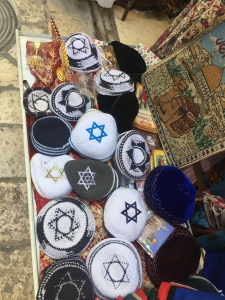 spices, leather pocketbooks stamped with geometric designs, Israeli flags, decorative yamakas, as well as food and drink. The shop owners would perch on low stools beside the street, watching the river of pilgrims pass by, hoping to entice some to tarry and make a purchase.
spices, leather pocketbooks stamped with geometric designs, Israeli flags, decorative yamakas, as well as food and drink. The shop owners would perch on low stools beside the street, watching the river of pilgrims pass by, hoping to entice some to tarry and make a purchase.
But perhaps it had been a bit like that in Jesus’ day, as he made his way toward Calvary, and the Roman guards beat their way forward against the throng of curious onlookers. Sometimes mean-spirited people would spit in the faces of the condemned. Of course there had been some acts of mercy: Station 6 depicts a woman named Veronica, who lived in a house along the way and wiped the sweat from the brow of Jesus. Today a chapel of the Convent of the Little Sisters of Jesus stands where Veronica once lived. We did not venture inside, but continued marching uphill toward Golgotha, the place of the skull.
****
We were traveling as a band of 45 pilgrims and two priests, trying to stay together amidst a tide of other tour groups. Several of our older members were using canes, and with the uneven paving stones and the crush of bodies, the way was precarious. It was such a struggle at the end of a long day that we did not pause at every station. When we finally reached the courtyard of the Greek Orthodox Holy Sepulchre, we lined up en masse and waited to get inside.
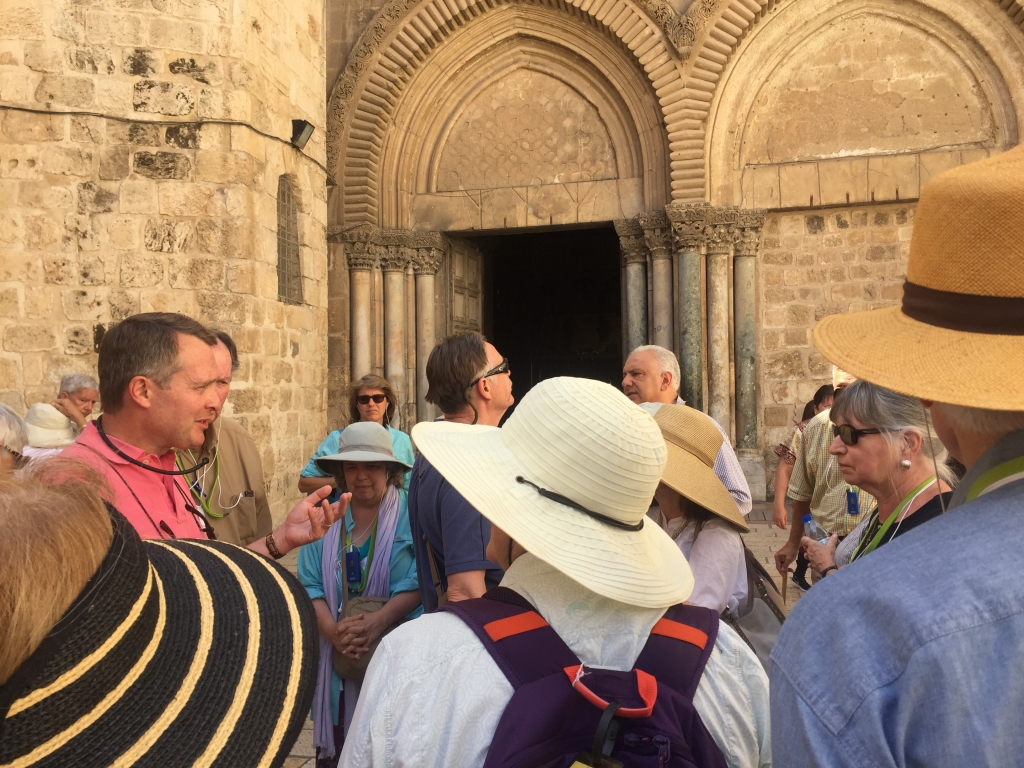 The scorching sun beat down overhead; nearby, a huge group of Indian pilgrims — all of the women decked out in bright saris — made their way forward as a pack; behind us, a tour group of Chinese pilgrims jostled us, restless to move forward. This site was the Motherload of sacred places because the church contained Calvary and the tomb where Jesus had been laid to rest. Of course, that means it also contains the place of his resurrection. I had not realized the garden tomb had been so close to the execution place, which was just outside the walls of the city. I questioned our guide Hanni about this, and he assured me that this was so. “He was laid in a nearby tomb,” Hanni said.
The scorching sun beat down overhead; nearby, a huge group of Indian pilgrims — all of the women decked out in bright saris — made their way forward as a pack; behind us, a tour group of Chinese pilgrims jostled us, restless to move forward. This site was the Motherload of sacred places because the church contained Calvary and the tomb where Jesus had been laid to rest. Of course, that means it also contains the place of his resurrection. I had not realized the garden tomb had been so close to the execution place, which was just outside the walls of the city. I questioned our guide Hanni about this, and he assured me that this was so. “He was laid in a nearby tomb,” Hanni said.
When we entered the mammoth basilica, my eyes fell upon the sight of a dozen Indian women kneeling around a pinkish rock slab. The women were prostate over the rock, wiping the holy oil from it and rubbing it on their skin. Some were crying; others were praying. Soon I learned that this was the Stone of Anointment where the body of Christ had been placed after his death. 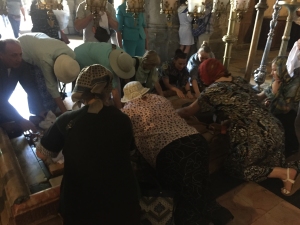 Somehow I managed to slip in beside these devotees of Jesus, running my fingers across the oily stone and feeling the mixture of grease and grit. I removed my decorative European scarf and ran it across the Lord’s resting place, picking up some of the oil. I wasn’t quite sure what collecting the oil was supposed to do, but I wanted to dive in and experience it.
Somehow I managed to slip in beside these devotees of Jesus, running my fingers across the oily stone and feeling the mixture of grease and grit. I removed my decorative European scarf and ran it across the Lord’s resting place, picking up some of the oil. I wasn’t quite sure what collecting the oil was supposed to do, but I wanted to dive in and experience it.
“You might have just ruined your scarf,” Sam told me, scandalized. I simply shrugged; from my point of view, its value had been enhanced.
Next we queued up to pass by the Rock of Calvary, now enclosed in an elaborate corner of the basilica. Pilgrims wait in line and pass single file until they reach an altar that marks the spot of the three crosses, with Jesus’ in the center. Underneath, you are permitted to squat down and stick your arm into a hole opened up in the bedrock by an earthquake following the death of Jesus. Naturally, every pilgrim is anxious to touch the place where the sacred cross stood.
Just as my turn approached, an Asian man jumped in front of me; oddly, he was not part of a group, but running solo. Even more strange, he was carrying a squirt bottle of Ajax disinfectant and a rag. I looked at our official “minder”, a black-robed Orthodox priest sitting in a nearby chair, to see if he would chastise the man. The cassocked priest did not move but only gave a look of annoyed resignation.
The Asian man, long black hair pulled into a simple ponytail, bent down and sprayed the rock, rubbing it vigorously. Now, I do not understand much about all of the Orthodox Church frenzy, but I had figured out that people valued the chance to soak up the holy oil anointing these sacred places. Why was this guy in here spraying Ajax and rubbing it all off? I felt like I was being cheated!
After several seconds, the priest motioned for the cleaning man to come over and sit near him; it was kind of like a teacher putting a kid in time out. I took my turn and touched the rock, but I was too distracted by the man’s antics and my curiosity about what would happen next to feel any religious fervor. As I filed past Mr. Ajax, he looked up and gave me a beatific smile, as if he had seen the heavens open to reveal the Lord and his angels. Clearly he had no remorse. Afterwards I learned that the man has “Jerusalem Syndrome”, meaning he is a local crazy; he comes to the basilica daily and repeats the same ritual.
****
 On the other side of the basilica, a small chapel covered the site of the empty tomb. This chapel dates back to time of Constantine the Great; yet it looked nothing like I had imagined, and I found it disappointing. I had expected a cave carved out of rock, a large stone that served as doorway, and perhaps a replica of the discarded funeral linens that had once wrapped the body of Jesus. So many people wanted to slip in and have their turn that we had perhaps five seconds within to look around. If I did not already know the Lord, I would not have found him there. The tomb bears the title “Christendom’s most sacred place”, but I believe I have felt closer to God sitting in my backyard in the grass and focusing my attention inward during times of morning prayer.
On the other side of the basilica, a small chapel covered the site of the empty tomb. This chapel dates back to time of Constantine the Great; yet it looked nothing like I had imagined, and I found it disappointing. I had expected a cave carved out of rock, a large stone that served as doorway, and perhaps a replica of the discarded funeral linens that had once wrapped the body of Jesus. So many people wanted to slip in and have their turn that we had perhaps five seconds within to look around. If I did not already know the Lord, I would not have found him there. The tomb bears the title “Christendom’s most sacred place”, but I believe I have felt closer to God sitting in my backyard in the grass and focusing my attention inward during times of morning prayer.
With the gaudy ornamentation of the church, the crowds, the gold-leafing everywhere, the public show of passionate devotion, as well as the unblinking faces of myriad saints painted on icons, the Holy Sepulchre felt more like a superstitious circus. How did we know that any of this was authentic?
Many layers of time and the rise and fall of empires — Roman, Byzantine, Caliphates, Crusader, Ottoman, British — have left their mark on the landscape. In the beginning, no one even knew it was important to preserve anything; it took time before the personal history of Christ became widely recognized as worth commemorating.
Much thanks is due to St. Helena, the mother of the Emperor Constantine the Great. Late in her life, Empress Helena traveled from her native Greece to Palestine, Syria, and Jerusalem, and she is credited with helping establish the authenticity of the Christian sites around 300 A.D. Many have been covered and preserved by Greek Orthodox and Catholic churches throughout the centuries. While the bearded church fathers have completely transformed the look and feel of these rustic places, thanks to them, these holy sites have survived inside the wide tent of Christendom.
One might think: is this the exact spot where the cross was planted? Is this the exact spot where Mary saw Jesus on the Via Dolorosa? At the very least, we were very close, and walking through the old city of Jerusalem, one could still feel the direct tie to the life of the person Jesus of Nazareth. Everyone always says once you visit the Holy Land, you will never read the Bible the same way again.
Now I understand: you can visualize the gnarled branches of the olive trees; the rise and fall of the rocky desert hills; the winding, narrow streets within the walled city; the crowds of people passing by wearing robes and head coverings. You have felt the overhead sun scorching your back; you have experienced a throat parched with thirst. You have dipped your flat bread into a bowl of hummus swimming with olive oil and tasted the rosemary and spices. You have picked up the scent and sense of the ancient days when the Master walked the earth, and you have felt him pass nearby.
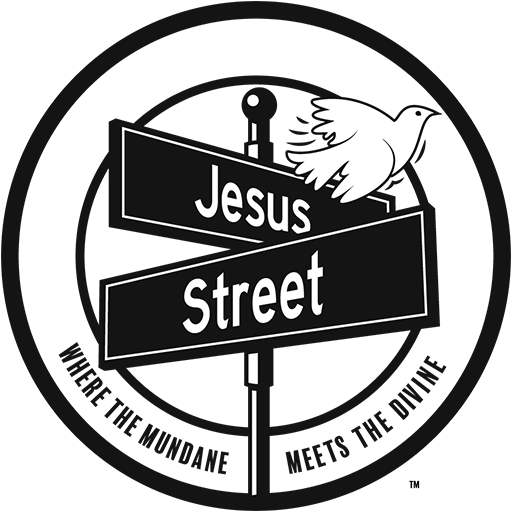
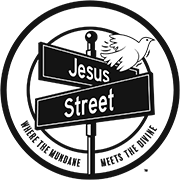







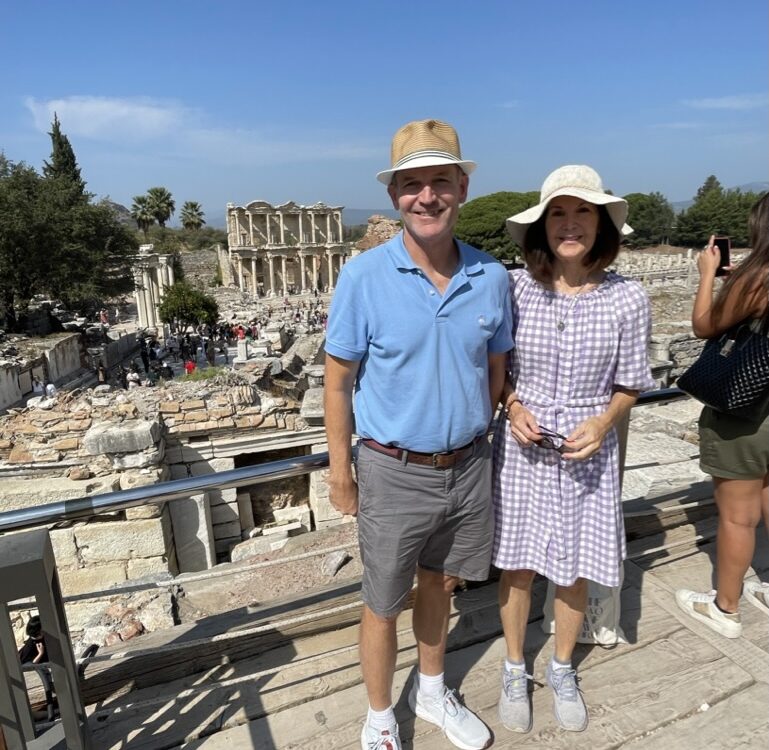


1 Comment
This was wonderfully and evocatively written, Pringle. We visited most of the sites you describe on our trip in 2009. I, too, found Caiphas’s house powerfully evocative, and I think many pilgrims do not visit it. Thanks for sharing your faith-filled experiences with us. See you very soon. Love, Margie